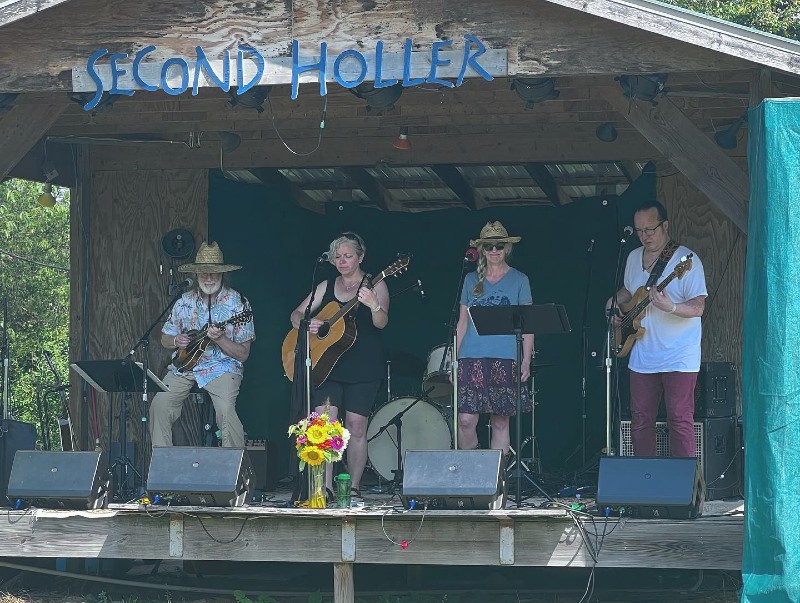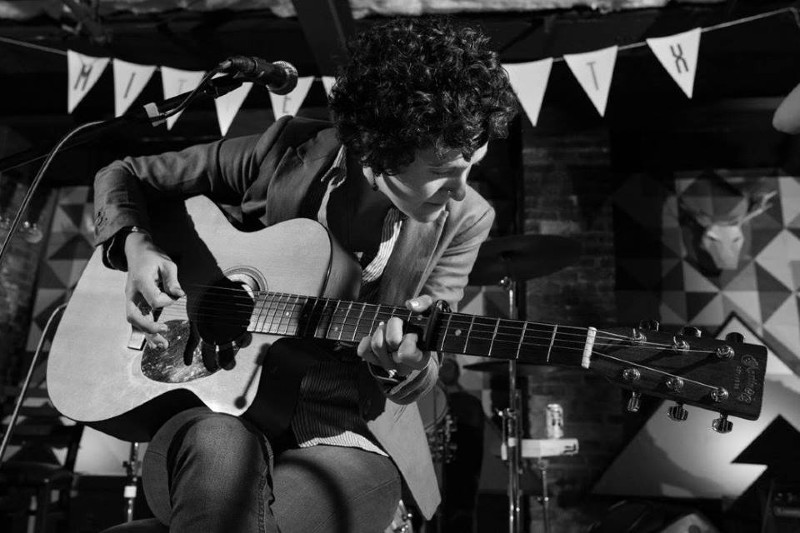Stephanie Heit's New Hybrid Memoir Poem "Psych Murders" Examines Shock Treatment, The Aftermath, and How Time and Memory Move in Unexpected Ways

What do you do when the brain “acts more colander than container?”
Poet Stephanie Heit tests out an answer: “Strengthen your faith in electricity.” Her hybrid memoir poem, Psych Murders, reports on the decision to experience and recover from electroconvulsive therapy (ECT) as a treatment for bipolar disorder. Psych Murders contains a number of sections, often titled with questions such as “What brings you pleasure?” and “Are you safe?”
This journey with shock therapy and other attempted remedies takes the poet to a point where:
…you forget
How to swim.
Forget
your tokens.
Lose any sense
of direction.
This path also later reaches a place where, “Hope became a location.” The poet expresses some bitterness that, “I thought they’d figure out the code. No lack of rigor. But my body didn’t respond the way the data predicted.” Still, the side effects like memory loss and frustrations do not fully define the process for Heit. Instead, Heit concludes with the poem, “Testament,” which consists of a series of “I am” statements that embrace all parts of her identity.
Shortly after the start of the book, the Murderer appears, often described in third person, but always menacing and forming his own character, as the poet observes, “…I’m not alone. I have Murderer stalking my every move.” In a distressful twist in the poem, “The Murderer: Primetime,” he gets a chance to speak and shares his goal to reach her because he states of the poet that, “She haunts me—the one who slow danced in my grip. I’ll wait.” Despite his persistence, the Murderer’s interest in suicide nevertheless does not come to fruition, a victory for the poet and us readers.
Instead, Heit describes learning to live with the circumstances. The poem, “Chronic,” shows a begrudging acceptance that:
Chronic sounds like forever. Persistent forever. With a twang to the way the “ic” sticks in the throat. Almost guttural. Starts out ok. Chron, like chronological, that domino effect, out of control falling because gravity exists. But the ending turns. I am stuck with Chronic the rest of my life. Better than Terminal unless it refers to airports. Though at least with Terminal there is beginning, middle, end. Chronic is middle with no way out.
The poet shows us how, on the one hand, Chronic comes with its downsides, but on the other hand, Chronic means being alive.
Heit is a queer disabled poet, dancer, teacher, and codirector of Turtle Disco, a somatic writing space, based in Ypsilanti. We spoke to Heit about her writing, teaching, latest book, and next project.
Bach to the Start: U-M professor Dr. James Kibbie revisits J.S. Bach's complete organ works in a series of concerts as he prepares to retire after 42 years

On the evening of April 16, when Hill Auditorium fills with the opening notes of Johann Sebastian Bach’s famous Passacaglia and Fugue in C minor, University of Michigan organ professor James Kibbie will be on the precipice of completing an incredible achievement.
This work is the final of Bach’s 281 solo organ compositions that Kibbie will perform in his 18-concert series that began in September 2022. It's a monumental musical offering that marks the end of Kibbie’s 42-year tenure as professor of organ at the University of Michigan.
The concert series also marks the culmination of Kibbie’s life-long relationship with Bach’s music.
“I’ve been working on this a long time,” Kibbie says. “Some of the first simple pieces I learned on the organ were by Bach.”
Keys to the Past: Ann Arbor’s Legacy of Theater Organs Creates Timeless Moviegoing Experience for Patrons

It was New Year’s Eve 2011 and we wanted a low-key way to celebrate.
My husband Brian suggested seeing The Artist, a critically acclaimed black-and-white-silent French film, at Ann Arbor’s Michigan Theater that evening.
The theater’s Screening Room featured a couple of showings, and we opted for the 9 pm show. That way, we could see the film and still get home to watch the Times Square ball drop at midnight on Dick Clark’s New Year’s Rockin’ Eve.
When we arrived at the theater, we saw a musician playing a Hammond organ about 20 minutes before The Artist started.
The organist provided pre-show entertainment and didn’t accompany The Artist during its screening, but his performance sparked our curiosity about the instrument, including the 1927 Barton pipe organ in the Michigan’s Main Auditorium.
For us, the theater organ served as a brief musical portal to the past, recalling a bygone era when it accompanied silent films at movie palaces from the 1900s to the 1920s.
Over the years, we’ve enjoyed seeing organists perform on Barton pipe organs at the Michigan Theater—the only one left in Ann Arbor—and Detroit’s Redford Theatre. Those beautiful theater organs offered warm welcomes as we took our seats to watch different films.
Nearly a decade later, I wanted to learn more about local theater organs, the theaters that housed them, and the organists who play them.
"This Was It": Normal Park Reflects on Its Decade-in-the-Making Debut Album

“So we’ll take process over outcome,” Jordan Mosley sings—or rather yells— on the sixth track, “settle,” from Normal Park’s this was it.
Mosley is the lead vocalist of an Ypsilanti fuzz-rock band of three high school friends who have been making music together for over a decade. Mosley is joined by drummer McKinnon Main and guitarist Anthony (Tony) Scott. Last October, the group finally finished the process and seized an outcome: its debut album, this was it.
Nestled midway through the album is one of the group’s favorite and most important tracks, “settle.” Like any great Midwest emo song, it begins on the porch. You can practically smell the American Spirits when you tune in.
“‘Cause staying in is much like going out / at least when we still had the choice / but since we don’t we can just make it easier to / settle the mind behind these red-laced bedroom eyes,” the chorus rings.
Although it may sound like an ode to quarantine, “settle” raises questions about fate, the promise of temporary relief, and what the future holds. It starts with a dance on the porch, teetering between going out and staying in, and by the end, you’re invited inside.
“It was kind of a lynchpin where it seemed to connect all the songs around it,” Scott said. “But it also felt like a real step forward lyrically for us. To step out of our comfort zone instrumentally was also a driving factor, and we really felt like we had something at that point.”
Courtney Faye Taylor explores racial injustices and the killing of Latasha Harlins in her debut poetry collection

Poetry becomes both memorial and voice in Courtney Faye Taylor's first book, Concentrate, winner of the Cave Canem Poetry Prize. The University of Michigan alum's poems honor, research, bristle, and circle back to the life and killing of Latasha Harlins, a Black girl gunned down by a Korean store owner, Soon Ja Du, in Los Angeles.
“In any black sentence, you’d love nothing more than to had made no mistake.” The opening prose poem that ends with this sentence mourns and fortifies Black womanhood. As Aunt Notrie says in the next poem, “The Talk,” it “Ain’t about trying, it’s about doing.” These lines do not let injustices lie but instead, “The poet wades into an uneasy ocean of interrogations that do not permit her any distance from what she has witnessed her entire life,” writes Rachel Eliza Griffiths in the introduction.
Some of the poems revisit history, like March 16, 1991, when Harlins lost her life. The poet starts another prose poem to outline how:
A timeline details a seriousness of events. As a diagram of occurrence, a timeline’s chief objective is to show how passed happenings caution and contaminate our contemporary sense of momentum. A professor may author timelines to teach what precedes and what follows genocide. On the overhead, Rwanda is a centipede with its head in Belgium and tail on stage of the ’05 Oscars.
The past remains with us as warning and blemish, and Taylor writes, “So I’m drawing a line.”
Other poems fashioned like Yelp reviews make stark the differences in treatment and standards among people. One of them gives two stars for “BLACK OWNED BUT HOURS WRONG ONLINE.” Such an offense garners a bolded complaint and strong consequence that “I will find a Korean store.” The loss of business for incorrect hours reinforces inequity and harshness.
Eventually, the poet goes to Los Angeles and visits the site of Harlin’s murder, “But there are no signs of murder, memorial, or resistance when I arrive. The ground is like any ground. Normalcy devastates. Stillness lies to me about history.” Taylor’s poems teach us that what is not visible is still present.
Early on, Aunt Notrie defines the word "concentrate" as “A strong, hard focus.” Taylor takes on that focus to scrutinize history through the poems. Later, Concentrate is a call to action, as in “Concentrate. We have decisions to make. Fire is that decision to make.” The word “we” leaves no one out. It is all of us who have responsibility.
Taylor is a writer and visual artist who earned her MFA from the University of Michigan, where she won a Hopwood Prize in Poetry. We spoke about Taylor's time in Ann Arbor, her poetry, and Concentrate.
"'I have a crisis for you': Women Artists of Ukraine Respond to War" acts as an archive of witness and response

"I have a crisis for you": Women Artists of Ukraine Respond to War was first shown at the University of Michigan's Lane Hall Exhibit Space last August 25 through December 16, and it was brought to U-M's Weiser Hall from January 3 through February 23.
And the curators don't think the exhibition is complete.
“I can’t say it's a finished project, because it will have afterlives,” said co-curator Jessica Zychowicz, director of the U.S. Fulbright Program in Ukraine, who also earned her Ph.D. from U-M.
She and co-curator Grace Mahoney—a Ph.D. candidate in Slavic languages and literatures, and a graduate fellow for exhibits at the Institute for Research on Women and Gender at U-M—hope the multimedia exhibit keeps finding new venues beyond Ann Arbor and can serve as an educational tool, or at least serve as an archive of work in which women describe and respond to their own particular experiences of war.
"I have a crisis for you" features paintings, writing, photos, and more by:
- visual artist and sculptor Kinder Album
- photographer J.T. Blatty
- visual artist and U-M grad student Oksana Briukhovetska
- visual artist and designer Sonya Hukaylo
- filmmaker, artist, and performer Oksana Kazmina
- visual artist Lesia Kulchynska
- poet and translator Svetlana Lavochkina
- visual artist Kateryna Lisovenko
- poet and screenwriter Lyuba Yakimchuk
Zychowicz and Mahoney did their curation remotely: Mahoney from Ann Arbor; Zychowicz from Warsaw, Poland, where she moved from Kyiv when the invasion began. To inform the project, the curators drew on previous relationships they had with the artists and writers as well as their own scholarship: Zychowicz is the author of Superfluous Women: Art, Feminism, and Revolution in Twenty-First Century Ukraine, and Mahoney is the series editor of Lost Horse Press' Contemporary Ukrainian Poetry Series.
Zychowicz and Mahoney recently talked with me over Zoom to discuss the exhibit. Our conversation was edited for clarity and length.
Annie Bacon and Kyle Rasche Come Together to Write the Michigan-Based Musical "The Keeper" and Perform Songs February 17 at Trinity House Theatre

Back in October, two Michigan folk singer-songwriters formed an unexpected partnership.
Ann Arbor’s Annie Bacon and Alto’s Kyle Rasche met at the Folk Alliance Region Midwest conference outside Chicago and quickly learned they would be ideal collaborators for a new musical.
“I think we both knew of each other, and I was a fan of Annie before we [had] actually met in person because she had written this amazing folk opera a few years ago,” said Rasche, who writes, records, and performs under the moniker Chain of Lakes.
Within only a few short hours of meeting Rasche, Bacon started writing the initial songs for a full-blown, stage-ready musical called The Keeper and shared them with him.
“I’d done my stalking and knew she’d be great to work with and immediately shared my dream with her to write a musical that had been germinating for a few years,” he said. “She came back to my room later to work on it with a bunch of it already written.”
Shannon Lee's Album "Stars" Follows an Emotional Journey Through Love and Loss

Shannon Lee wanted her new album to progress like an emotional journey, from the pain of a broken relationship and the loss of a loved one to the rediscovery of love. The seven songs on Stars trace that quest, though it’s a subtle sojourn.
“I’m not sure if other listeners can tell but I wanted to start the album off with my heartache and loss and have the album move toward lighter themes, which I think I accomplished,” said the Ypsilanti-based Lee.
“Anymore” and “I’ve Gone Away” cover the break-up phase, while “Brother” recounts the tragic loss of her brother on New Year’s Day four years ago and “Stars” imagines his light shining down on her. Lee then pays tribute to a fellow songwriter on “Sunni Leilani” and closes Stars with two songs, “Here to Stay” and “Sing to Me,” that revel in love.
Lee’s songs share elements reminiscent of folk and Americana artists such as Emmylou Harris, Brandi Carlile, Patty Griffin, and Lucinda Williams, and cites artists who were played in her house while growing up as influences.
“I always had an ear for music; ever since I was a kid,” Lee said. “I had a knack for picking out harmonies in three or more part harmony singing, too, and always found myself singing along to my dad’s records. His collection of course had Fleetwood Mac, Led Zeppelin, Crosby, Stills and Nash, and many more in that classic rock vein.”
Tight Fit: Misty Lyn & the Big Beautiful worked their way through a car crash and a pandemic to navigate the "Narrows"

It’s been a while since local acoustic music fans have heard from Misty Lyn Bergeron, the accomplished singer, songwriter, and leader of the standout roots band Misty Lyn & the Big Beautiful.
A serious car crash, a global pandemic, and other issues created some challenges and delays, but at last there’s a new album out, Narrows, and it’s more than worth the wait. It features Bergeron’s warm, expressive voice; her first-rate band, and a fresh batch of well-crafted songs about some big themes like love, friendship, and perseverance.
To celebrate Narrows, Misty Lyn & the Big Beautiful are having a record-release show at The Ark in Ann Arbor on February 17.
"Jim Roll will be our special guest, and it’s also how I’m celebrating my birthday," Bergeron said. "The Ark is my absolute favorite venue, and it has been years since my whole band has been on that stage. I am so excited to share this music alongside these amazing artists. It’s going to be a special night for us!"
Bergeron is also a talented photographer, but we focused on her music in this email interview.
U-M students go back to the Victorian era in Oscar Wilde’s “The Importance of Being Earnest"

It was still early in rehearsals and cast members were beginning to master an unfamiliar language as well as a different set of values in a distant time. It was the ’90s when a queen reigned and defined an age.
No, not the 1990s, the 1890s.
That’s when Oscar Wilde’s The Importance of Being Earnest made its debut.
The University of Michigan School of Music, Theatre & Dance will present Wilde’s giddy and ever-popular comedy February 16-19 at the Arthur Miller Theatre.
Every year musical theater majors at the University of Michigan perform in a non-musical production. It’s all part of making theater students at ease in both musical and non-musical productions and honing their skills.
Production director Vincent Cardinal, a professor of musical theater at the University of Michigan, has directed and produced scores of productions across the country and is also a noted playwright. Cardinal said Wilde makes it easier for the actors to get into the Victorian era.
“You’re never in better hands than someone like Oscar Wilde,” Cardinal said. “Wilde is going to give them great language, really great characters, and they’ll be really good. When not solving problems, they’re becoming really good at their craft.”


































